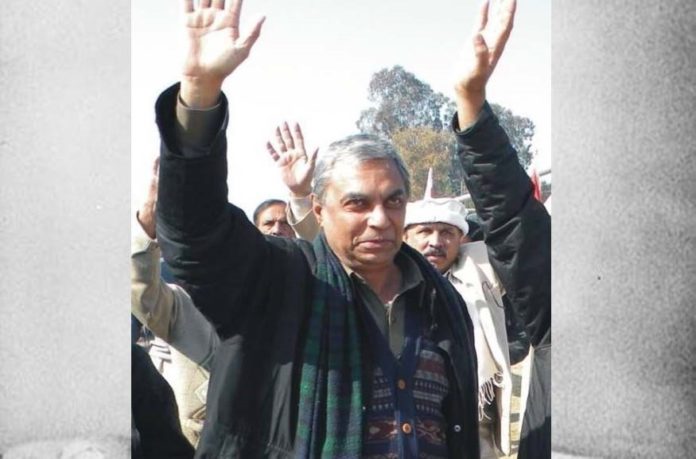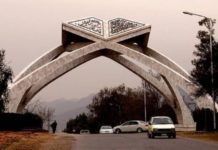
It was late 1979 or maybe early 1980 when I first met Jamil Omar. You could right away see that he was someone unusual. With intense, sparkling eyes and a determined chin, this young man had just returned from Romania and joined Quaid-e-Azam University as a junior lecturer in the computer science department. Many of his immediate colleagues belonged to the extreme right-wing Jamaat-e-Islami. Feeling the suffocation, he soon reached out to the handful of progressive teachers and students in other departments across the university campus. He was soon to become their leader. Those were terrible times for Pakistan. After the 1977 coup of guns and theology, the jails were full, public floggings had become popular entertainment, and there was busy traffic at the gallows. On many campuses, emboldened Islami Jamiat-e-Talba students would smash their opponent’s heads with lathis, or torture others by grinding lighted cigarette butts onto their bodies. It is difficult for me to forget one such occasion when some of the QAU physics faculty Faheem Hussain, Abdul Nayyar, and myself received timely information and rushed to save one of our students, Tayyab Yazdani, from the Jamaat’s torture chamber in Hostel Number 2.
With energy that seemed limitless, Jamil set about organizing resistance to the military dictatorship and its fascistic religious allies on campus. Secrecy was essential. Intelligence agencies were ubiquitous, snooping for every tiny hint of dissident opinion. Jamil tasked a small group of teachers Tariq Ahsan, Mohammed Saleem, Abdul Nayyar, and myself to secretly set up a small reading group and write something from time to time. Miraculously some of this would appear in a thin few-page pamphlet called Jamhoori Pakistan (Democratic Pakistan). This underground left-wing publication was critical of the military government and its principal ally the United States. I knew, but only vaguely, that Jamil had something to do with it..
Even this modest pamphlet was considered dangerous. Censorship was total and complete in those days a far cry from today’s unfettered, though often meaningless, chatter on television. Democracy was a word so foul that none but the bravest dared utter it. Print, radio, and television were controlled with an iron hand. How then was one to protest the cruel suppression? The terrorists of Al-Zulfiqar, guided by the two Bhutto brothers, Murtaza and Shahnawaz, took potshots at the regime. Al-Zulfiqar’s occasional assassination of government officials, and abortive attempt at firing a missile at Zia-ul-Haq’s plane, had done absolutely no good. On the contrary, such random stupidities caused the heavy hand of the state to come down ever harder upon all and to further suppress voices of dissent.
Our group of QAU colleagues knew but one way of effectively communicating dissent. This meant writing slogans on walls in Islamabad and Rawalpindi under the cover of night. Our working class allies would emerge from alleys, quickly paint slogans using a bucket and brush, and then disappear as fast as they possibly could. But this became increasingly more hazardous, and those of us with motorbikes or cars were sometimes pressed into service. Moonlit nights were to be avoided unless absolutely necessary..
As this “wall chalking” grew more dangerous, Jamil set out an engineering problem for me: I must devise something that would allow chalkers to dispense with the cumbersome brush and bucket. Experimentation with an empty detergent bottle, shaving brush, metal shoulders, pieces of pipe, and used black engine oil yielded success. The next step was to bulk manufacture the devices in my mother-in-law’s home, where we lived. Thereafter our wall chalkers became more mobile and less detectable. When Caspar Weinberger, the US Secretary of Defence, arrived in Islamabad sometime in 1981, he was greeted with painted slogans harshly condemning America’s role in Afghanistan and its support for the military regime. Zia was furious. The authorities doubled the patrolling, hoping to catch the chalkers.
And then, as luck would have it, everything crashed to an end on the midnight of 3 November, Jamil Omar was slipping copies of Jamhoori Pakistan under the closed shutters of shops in Islamabad’s Melody Market when a night watchman apprehended him, and then wrestled him to the ground. The little 50cc Honda motorcycle that he had travelled on, borrowed from colleague Tariq Ahsan, was seized. In the morning, Tariq Ahsan and Mohammed Saleem were arrested. A picture of “subversive books” seized from Saleem’s house, where we held our weekly meetings, appeared in the newspapers. At the very top was Cancer Ward by Aleksandr Solzhenitsyn, the famous anti-stalin dissident. In those days, every Russian was automatically assumed to be a communist and hence an enemy of the Islamic Republic of Pakistan..
General Zia-ul-Haq was ecstatic after the arrest. He rewarded the night watchman handsomely. A day later, he appeared on television vowing to rid QAU of the “cancer of politics” and the “scourge of communism”. Tariq and Saleem were jailed, the houses of many QAU colleagues were raided and some were briefly held. Sarwar Bari, then a student, escaped. He returned years later..
But the harshest treatment was reserved for the ring-leader. And so Jamil was made to “disappear”. As we learned much later, he had been transferred to an ISI safe house in Islamabad where he was hung upside down and naked from the ceiling, a lighted match was held to his genitals, and thrashed mercilessly until he confessed. From his house, which I had persuaded another friend to rent to him, a Gestetner cyclostyling machine was discovered. Unknown to that friend or to me, Jamil had been the editor, publisher, and printer of Jamhoori Pakistan!
Some days after his arrest a battered and bruised Jamil, in police custody, turned up at my mother-in-law’s house at B-1357 Satellite Town, Rawalpindi. Under torture he had revealed that the chalking devices seized from his house had actually come from me. But, after searching the house, they found nothing. Some weeks earlier, together with my wife Hajra and 2-year old daughter Asha, I had left for a post-doctoral appointment in nuclear physics at the University of Washington in Seattle..
Meanwhile young Zulfiqar, my wife’s brother, had destroyed all evidence of my little factory. Jamil had named only me in his FIR, knowing that I was away. By doing so he saved many others such as Faheem Hussain, Jane Hussain, and Abdul Nayyar who were even more involved than I was..
In subsequent months Jamil’s legs were strapped with steel fetters (bayrian). These made bending down impossible. The other two prisoners were not subjected to such horrific treatment, but all three were transferred after short periods to jails in Multan, Mianwali, and other far off places. This was done to make it difficult for friends and relatives to visit. By this time I had returned from Seattle and could visit them. Although I had gone there on a year’s fellowship, Faheem and Nayyar had warned me that it would be unwise to return for at least another year..
Jamil was finally released in 1985 from prison, the result of international pressure that was brought to bear upon Zia’s regime. Tariq and Saleem had been released a year earlier. The lives of our three friends had been transformed drastically, but none had been more badly affected than Tariq. A PhD student at Carleton University in Ottawa, he had come back briefly to be with his family. Fate could not have been harsher to him; just as he was arrested his very dear younger sister Tazeen died from a mysterious illness. Traumatized and psychologically vulnerable, this 25 year-old developed arthritis, an old person’s disease, while in prison. I think Jamil always felt a kind of guilt about Tariq: he had not told him the purpose for which he had borrowed Tariq’s motorbike..
Jamil’s arrest, torture, and subsequent jailing marked the peak of repression during General Zia’s regime. The trade union movements we had worked with in earlier years had gone underground and then withered away. Student unions, active earlier, were banned; there are still none even today. The ugly face of religious fascism was to be seen everywhere. Textbooks dripped with hate against Hindus and non-muslims. Everything including science and mathematics was subjected to the charade of Islamization..
Pakistan has yet to recover from the wounds inflicted by Zia’s murderous dictatorship. But, amazingly, Jamil did bounce back. Prison and torture had left him undaunted. Erudite and articulate, passionate and dedicated, his energy was inexhaustible. For the remainder of his life a good thirty years more he lived to do what he could to further workers power, socialism, and democracy. He wrote books, organized, and pleaded for Left unity among Pakistan’s fractious and chronically divided Left. As a powerful speaker, he was much sought after. Alas, he put his ailing heart to more stress than it could bear until it finally gave way on 17 March, 2014.
Jamil and I never worked together again after the early days. Our respective world views had begun to diverge, and we went our own separate ways. But when on occasion we happened to meet, it would be with the greatest affection and regard. This man of steely courage, iron determination, and deep humanity will be deeply missed by his very many admirers, comrades, and friends.
Published in Daily Times on March 21, 2014 and Viewpoint in its Issue No. 193







